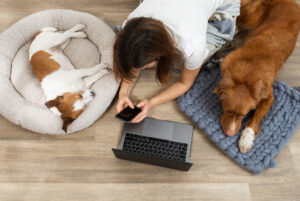When it comes to taking your pet to work, there are some important considerations to factor in.
Workplaces are typically designed for humans, not dogs or cats or other animals. They are also places specifically designed for work, not play time.
Paws N’ All has previously spoken with three dog parents about what it’s really like to take your pet to work. And another dog parent also shared some insights into the question: Can you take more than one dog to work together?
We’ve also explored vet advice on working from with pets in our ebook Guide for dog owners during COVID-19.
Combining all these perspectives, we’ve compiled a simple checklist of tips for taking your pet to work to help make the experience a positive one for everyone.
Tips for taking your pet to work
There are a number of do’s and don’ts when it comes to taking your pet to work. Perhaps the most important of all is addressing territorial behaviours.
“That was the one thing the dog trainer said – you need them to have their own space within the office. Otherwise it’s a [potential] nightmare, because the dog thinks the whole office is theirs and everyone’s an intruder,” Emily-Rose Hills recalls from her experience with her dachshund Daisy.
“Whereas if you have the fabric crate under your desk, they know that’s their safe space.”
The following is a practical list of do’s and don’ts for taking your pet to work, to ensure it’s a win-win for everyone:
Do:
- Ensure the workplace is safe for them: That means not exposing your pet to dangerous machinery or equipment. And having a secure environment from which they can’t escape.
- Ensure the workplace is safe for you: Just like at home, your pet may want to lie at your feet while at work. That can be a trip hazard for you and your colleagues – especially if your pet is small or a similar colour to the flooring!
- Make sure your pet is friendly: If they bark or growl at strangers, or feel threatened by a particular type of person, it may be wise to rethink taking them to work.
- Check whether anyone has allergies: Your dog or cat probably won’t be a good fit if it means someone on the payroll can’t be in the office.
- Walk your dog before you get to work: It will encourage them to sleep once you arrive.
- Plan your work day: You’ll need to incorporate regular toilet breaks for your dog.
- Notify visitors and customers: Tell them that your pet is on-site before they arrive. It avoids awkward surprises (and they may even bring your pup a treat!)
- Keep treats on hand: Chewy but non-crunchy treats are ideal, keeping them busy without distracting you and your co-workers.
Don’t:
- Let them become territorial over the whole office: Be sure to give them their own safe space, such as a bed or crate under your desk.
- Assume your pet is welcome at work: Some people don’t like or are afraid of particular types of pets. And some workplaces can’t safely or legally have a pet on the premises – assistance dogs are an exception. Always ask your employer first.
- Leave them unsupervised: They may get into mischief or become a distraction for other people. Or they could escape or wander into dangerous areas.
- Let your pet get bored: Bored dogs and cats can be very disruptive. Make sure they have a comfy bed and some squeaker-free toys for napa/quiet play time.
- Forget to bring poop bags! Keep a stash of them in your desk drawer so you don’t forget them in the morning rush.











